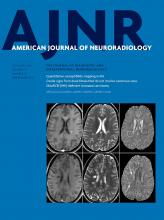Abstract
BACKGROUND AND PURPOSE: Magnetic susceptibility values of multiple sclerosis lesions increase as they change from gadolinium-enhancing to nonenhancing. Can susceptibility values measured on quantitative susceptibility mapping without gadolinium injection be used to identify the status of lesion enhancement in surveillance MR imaging used to monitor patients with MS?
MATERIALS AND METHODS: In patients who had prior MR imaging and quantitative susceptibility mapping in a current MR imaging, new T2-weighted lesions were evaluated for enhancement on conventional T1-weighted imaging with gadolinium, and their susceptibility values were measured on quantitative susceptibility mapping. Receiver operating characteristic analysis was used to assess the diagnostic accuracy of using quantitative susceptibility mapping in distinguishing new gadolinium-enhancing from new nonenhancing lesions. A generalized estimating equation was used to assess differences in susceptibility values among lesion types.
RESULTS: In 54 patients, we identified 86 of 133 new lesions that were gadolinium-enhancing and had relative susceptibility values significantly lower than those of nonenhancing lesions (β = −17.2; 95% CI, −20.2 to −14.2; P < .0001). Using susceptibility values to discriminate enhancing from nonenhancing lesions, we performed receiver operating characteristic analysis and found that the area under the curve was 0.95 (95% CI, 0.92–0.99). Sensitivity was measured at 88.4%, and specificity, at 91.5%, with a cutoff value of 11.2 parts per billion for quantitative susceptibility mapping–measured susceptibility.
CONCLUSIONS: During routine MR imaging monitoring to detect new MS lesion activity, quantitative susceptibility mapping can be used without gadolinium injection for accurate identification of the BBB leakage status in new T2WI lesions.
ABBREVIATIONS:
- Gd
- gadolinium
- GRE
- gradient echo
- ppb
- parts per billion
- QSM
- quantitative susceptibility mapping
- © 2016 by American Journal of Neuroradiology
Indicates open access to non-subscribers at www.ajnr.org







